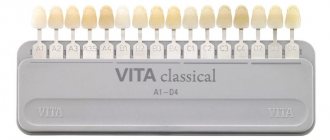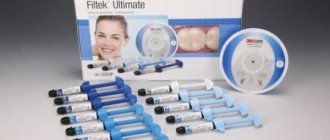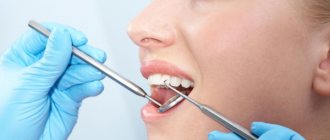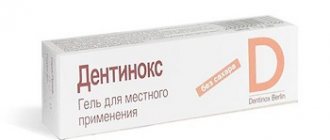Carious disease manifests itself in many cases quite unnoticed, very often having a small black dot in the tooth; when visiting the dentist, very deep caries is discovered.
Basically this confuses us and we immediately start thinking about what we should do, what material is better to use and how much it will cost us. We can answer all your questions without difficulty.
We want to tell you and offer the modern nanocomposite material Filtek. Its application is very wide, from the smallest restorations to filling large volumes of voids. In this article we will tell you about what Filtek restoration fillings are. About the areas in which they are used. We will also talk about the undoubted advantages of this light-curing material. And of course we will tell you about the different types of Filtek fillings.
What are Filtek fillings?
Filtek fillings are the word quality in the highest form of restoration materials from the American manufacturer - 3M ESPE. Similar nanocomposite materials for filling are used all over the world. With their use, it is possible to restore dental aesthetics, excellent anatomical shape and chewing function.
In what areas are Filtek materials used?
Filtek material is a nanocomposite material, its use is very extensive. Unlike many other materials, Filtek is used not only in the restoration of chewing teeth, but also in cases where it is necessary to restore the aesthetics of the front teeth. This material is universal!
Let's now list the undoubted advantages of this material!
Price
The price of the Filtek composite material depends on the kit’s configuration , so for the Single Shade and Dual Shade packages a specialist will have to pay from 10 to 12 thousand rubles. A professional kit will cost 24-27 thousand rubles.
The cost of a Filtek filling for a patient depends on the volume of restoration performed. So, restoring the surface of one tooth will require 1500-1650 rubles. For the restoration of two surfaces you will have to pay about 1750-1900 rubles.
Advantages of Filtek fillings
- Filtek fillings are used not only in frontal teeth, but also in chewing ones
- Low landing
- Reproducibility of natural properties of enamel and dentin
- High aesthetics and smoothness.
- Good wear resistance.
- Material from a well-known company provides a guarantee of effective treatment
- Of course, this manufacturer has a huge range of colors.
Now let's talk about the types of Filtek filling material.
Recommendations and warnings
The presence of polymer resins in the Filtek composite requires careful handling of the material. It is necessary to ensure that the substance does not come into contact with the skin , so manufacturers recommend carrying out the filling procedure with gloves and carefully isolating the soft tissues of the patient’s oral cavity.
If the composite comes into accidental contact with your skin, you should immediately wash your hands with plenty of water. Contact of a substance with a glove requires removal of the glove, washing of hands with soap and use of a new pair of gloves.
Filtek filling material must be stored in tightly closed syringes for 3 years from the date of manufacture.
To ensure that the quality characteristics of the drug are preserved, exposure to direct sunlight should be avoided.
Types of Filtek filling material:
There are three types of Filtek fillings: Filtek Z250, Filtek Supreme and Filtek Ultimate.
So, the first one: Filtek Z250 - this material has good density, which allows it to adhere well to the edges of the teeth. This material is used in the so-called layer-by-layer technique, which means the moment when the filling is built up and more than one layer is used. This material minimizes the recurrence of caries to almost zero.
Second: Filtek SupremeXT - this material is great for making veneers or inlays. This material has a large number of shades, which makes it an excellent option for the restoration of front teeth.
And finally the third type: Filtek Ultimate - this material is newer, it was developed to improve and improve the Filtek Supreme material. It's essentially the same thing, but it has an improved formula for long-lasting shine. This material is also more convenient for the dentist to use, which will make the procedure faster.
Filtek Ultimate XT 'Filtek Ultimate' Dentin shades Ultimate Universal Restorative is a light-curing composite developed for use in the anterior and posterior regions. All shades are radiopaque. A dental adhesive, such as one from 3M ESPE, is used to permanently bond the restoration to the tooth structure. The material is available in a wide range of shades: Dentin, Body, Enamel, Translucent. The material is available in syringes. Indications for use Restorative material Filtek TM Ultimate is indicated for: • Direct restorations in the anterior and chewing regions (including occlusal surfaces) • Stump superstructures • Splinting • Indirect restorations (including inlays - onlays and veneers) Composition The resin is slightly modified compared to FiltekTM Z250 Universal Restorative and FiltekTMSupreme Universal Restorative. This resin contains BiS-GMA, UDMA, TEGDMA and BIS-EMA resins. To reduce shrinkage, part of the TEGDMA resin in FiltekTM Supreme XT was replaced with PEGDMA. The filler is a combination of free 20 nm silicon nanoparticles, 4 to 11 nm free zirconium particles, and silanized zirconium-silicon clusters (consisting of 20 nm silicon particles and 4-11 nm zirconium particles). In the shades Dentin, Enamel and Body, the cluster size ranges from 0.6 to 20 microns. By weight, filler is 72.5% (55.6% by volume) for Transluscent shades and 78.5% by weight (63.3% by volume) for other shades. 4 Shades The system consists of the shades of 4 opaques, shown here in order of decreasing opacity: Dentin (most opaque), Body Enamel and then Translucent (very transparent). The differences in opacity are shown in Figure 1. The transparency of the text under the 1 mm thick composite discs reflects the opacity. Translucent shades are very transparent, so we see the text unchanged at the transition border. Enamel shades have a transparency similar to that of enamel. The text seems a little blurry, but is still readable through the disc. The Body shades are more opaque and less transparent than the Enamel shades, allowing them to be used for single-color restorations. The text is still readable, but very vague. Dentin shades have the highest opacity. In multi-color restorations, Dentin shades are used to replace the more opaque dentin structure, after the Dentin shade underlays, the passage of light through the restoration is blocked. The shade system is based on the classic VITA scale with the following exceptions: For whitened teeth: White Dentin, Body, Enamel (WD, WB, WE) Extra White Body, Enamel (XWB, XWE) For cervical restorations: A6B and B5B Transparent shades: Clear, Blue, Gray, Amber. The coloring has been modified compared to Filtek tm Supreme XT Universal Restorative. The differences in color are a reduction in the number of Dentin shades (A6D, C6D,XWD are removed). The diagram shows the color coding used in FiltekTM Ultimate. The darker the color code, the more opaque the composite has. The number of Body shades has been increased by the addition of A6B and B5B for cervical restorations and D3B. XWE enamel shade has also been added. Additionally, the transparent shades Violet and Yellow were replaced with Blue and Amber. 5 Fluorescence and Opalescence Fluorescence and opalescence are also aesthetic properties of a natural tooth. It is believed that these two properties are responsible for the play of color and “liveness” of tooth tissue. In natural teeth, dentin (especially hydroxyapatite and organic matrix minerals) exhibits higher fluorescence than enamel. Fluorescence occurs when light energy is absorbed and emitted at a longer wavelength. In teeth, this means absorption of light in the UV spectrum (350-365 nm) and emission of light in the visible spectrum (about 400 nm). As seen in Figures 2 and 3, the teeth fluoresce white and blue. Note that some materials fluoresce more than natural teeth, while others, such as Filtek™ Ultimate Universal Restorative, fluoresce at the same level and in a similar color. Opalescence, on the other hand, refers to the way a material scatters shorter wavelengths. This is demonstrated by a blue glow when light is reflected and an orange-brown glow when it is carried out. Natural enamel has an opalescent effect. By modifying the nanoclusters used, Filtek™ Ultimate transparent shades provide a level of opalescence equal to that of natural teeth (based on literature data on the level of opalescence of natural teeth). Color Basics Color Shade is the actual color of the material. The scale below shows shades from blue to yellow. VITA scale shades A shades Red-brown B shades Red-yellow C shades Gray D shades Red-gray Color saturation is its intensity. The larger the numerical designation (for example, A3 compared to A1) in a group of shades, the more intense the color (A3 is more intense than A1). Combination of light/dark tones. Higher (lighter) for shades A and B. Shades C and D are grayer than A and B. Generally speaking, shades C are less saturated than shades A. Research has shown that tooth color in adult teeth is determined by mainly a shade of dentin. The enamel layer plays a much smaller role in the actual color of the tooth. • Younger people have brighter, less translucent teeth. With age, the enamel layer thins, exposing more dentin, so the teeth appear darker, especially in the cervical third. • The cervical areas will be more saturated in shade due to the thinner enamel layer, which makes dentin more visible. • The Body area is a combination of dentin color, with a slight overlap of the enamel layer and surface morphology features. According to the literature, the color intensity in the middle third of the crown (Body) is 1-2 colors brighter than in the cervical area. • The incisal edge region has a greater degree of translucency as the amount of dentin present decreases as it approaches the incisal edge. Opacity Considerations When light contacts a tooth: • The enamel scatters and conducts the light. If the dentinal layer is very thin, or if there is no dentin layer under the enamel layer (such as in the incisal area), some light passes through the tooth into the oral cavity. The oral cavity can reflect light back through the enamel. • When light reaches dentin, some of it is absorbed and some is reflected and passed back through the enamel. • The light that is reflected and refracted forms the color of the tooth • The texture of the tooth surface plays a role in the perception of color - a smoother surface will appear whiter (lighter) than an uneven one. Key Opinion Leaders 18 key dentists were invited to share their views on recommended working and treatment techniques, educational methods, strength and friability of existing composites, and available color options. Key thoughts on this: • It is very important to come to an agreement with the patient regarding the level of his aesthetic wishes • Color selection scales are used at the initial stage of color determination, then it is better to use in-vivo mock-up techniques to more accurately determine which composite color is best suits the surrounding tooth tissues. • The acceptability of the final result of the restoration depends on the following factors: the correct selection of color, its depth and the combination of the selected color with natural tooth tissues (achieved, for example, by applying a transparent shade to a less transparent one, or building the incisal edge with a transparent shade), surface polishing and the morphology of the tooth surface and doctor and patient preferences. Recommendations for choosing the color of Filtek Ultimate Universal Restorative material 1. After cleaning the tooth surface (carrying out professional hygiene), determine which colors you will need. Do this before preparing the tooth or installing a rubber dam. An overdried tooth will be brighter than a normal one. Thus, the color chosen on a dry tooth will be brighter than the normal shade after rehydration. 2. When choosing a color, • If you plan to use one shade, select the Body shade, focusing on the middle third of the crown of the tooth. Select the color as accurately as possible, also focusing on the middle third of the tooth on the VITA scale. • If you plan to use more than one shade to accurately represent the tooth structure and obtain the best vitality of the restoration, use the shade wheel (described below) to determine which opaques to use. To decide on the choice of shade in a given opacity, you must:
— Select the Dentin (or Body) shade, focusing on the cervical area of the tooth. Select the color of the composite that is more suitable to the color of the cervical part of the tooth from the VITA coloring - Select the Body shade, focusing on the middle third of the tooth crown, also focusing on the middle part of the tooth from the VITA coloring - Select the Enamel shade, focusing on the incisal edge of the front tooth, or the tops of the lateral cusps teeth. Select a composite shade that more closely matches the central part of the tooth on the VITA scale - A transparent shade (in the same light range) can be used to increase transparency and increase the “depth effect” of the restoration. 3. Mock up the restoration before etching. The color of the composite can be affected by the thickness of its layer. Composites may change color after exposure. Place and illuminate the composite of the intended thickness over the area of the planned restoration. Obtain patient consent for the chosen color. Remove the mock-up using a probe. 7 4. Evaluate the color match of the scale and mock-up in different lighting conditions. 5. When grinding and polishing the restoration, imitate the surface morphology of natural teeth. Color Selector Wheel To assist in the color selection process, 3M ESPE Filtek Ultimate Universal Restorative features a unique, patented color selector wheel. Once you have decided on the main shade on the VITA scale, the selector scale offers you recommendations for restoration using one shade, two shades, or a multi-color technique. • Select a shade according to the VITA scale: determine the shade that most closely matches the color of the middle third of the tooth crown. • Select the side of the selector wheel you need, according to the type of restoration you intend to perform. • Turn the wheel until the shade you selected appears in the inner circle. • Follow the Filtek Ultimate chart for one-color, two-color, and multi-color techniques. It should be noted that this tool is only a guide. The final result will be influenced by the thickness of the composite layers, surrounding tooth tissue, neighboring teeth, etc. Next, layering diagrams displayed on the scale offer potential solutions to achieve a specific aesthetic result. For example, Translucent can be applied internally, as shown to create translucency in the incisal third of a Class IV restoration. As an alternative not shown in the diagram, Transluscent can be applied superficially on the labial or occlusal surfaces to create depth in the restoration. If you use a transparent shade in this way, the color of the restoration may become darker; to avoid this, you can apply a shade one step lighter than the one chosen exactly under the intended layer of Transluscent shade.
Our clinics
Clinic "Elident" on Varshavskaya
Varshavskoe highway, 75, bldg. 1, Moscow 117556
- Varshavskaya (500 m, closed until 2021)
- Nakhimovsky Prospekt (1,300 m)
Mon-Sat : 09:00-21:00; Sun : 09:00-19:00.
Online registration
+7 (495) 649-41-19
Elident Clinic in Annino
Varshavskoe highway, 154, building 1, Moscow 117405
- Annino (500 m)
- Academician Yangelya (700 m)
Mon-Sat : 09:00-21:00; Sun : 09:00-19:00.
Online registration
+7 (495) 649-41-19
Restoration methods
After all the preparatory work has been completed, a method for restoring lost teeth or dental surfaces is selected. Two main methods are used .
Direct recovery
In this case, restoration is carried out in the following order:
- The required cavity is processed.
- A pad with medicine is placed inside (if necessary).
- A matrix is inserted to ensure interaction between adjacent teeth.
- Dentin and enamel are etched.
- The adhesive is applied and time is given for its polymerization.
- The required amount of composite is placed in a block protected from light. The syringe with the remaining material should be immediately closed with a cap.
- The composite is applied in layers similar to tiles into the finished hole.
- Each layer should be illuminated in turn with a lamp containing halogen or LEDs.
- The filling is given the required contours using burs and finishers.
- It is necessary to ensure contact between the teeth - the filling is adjusted if it is insufficient. In this case, articulating paper is used.
- Final grinding and polishing of the restored area is carried out.
Indirect technique
Obviously, this method is much more labor-intensive. But in some cases there is no choice, and restoration of a lost tooth is only possible using the indirect restoration method.
This method includes the preparatory stage described above and the following operations:
- The doctor selects the type of structure and performs a complete treatment of the tooth.
- An impression is taken from the processed unit.
- In the laboratory, plaster models are made from a cast.
- The finished model is covered with a separating layer.
- The composite is applied to the tooth in layers, each layer is processed with a special light lamp.
- Formation of the desired contours and polymerization.
- The structure is adjusted, finished and polished, followed by testing on a tooth model.
- The doctor checks the stability of the structure in the treated cavity. If defects are found, they are eliminated at the place of manufacture.
- A rough texture is created on the internal surfaces.
- The prosthesis is treated with a soap solution by placing it in a bath with ultrasound. After this, it is thoroughly washed with water and dried.
- The finished product is fixed in the desired place with special cement.
Prices for caries treatment
| Service | Price, ₽. |
| Examination of the patient, calculation of the cost of services | for free |
| Light polymer (Light) filling Estelite | 2800 |
| Light-polymer (Light) filling Vitrimer | 2700 |
| Light polymer (Light) filling Filtek | 2500 |
| Fuji glass ionomer cement | 2200 |
| Light-polymer (Light) filling Revolution (for a crown) | 1800 |
| Treatment of average caries MOD Estelite | 4000 |
| Treatment of average caries MOD Filtek | 3800 |
| Treatment of medium caries MOD Fuji | 3500 |
| Grinding the filling | 350 |
| Temporary filling with Septopak medicinal preparations | 550 |
| Temporary filling (dentin) | 300 |
| Temporary light filling Clip | 400 |
| Fuji insulating gasket, revolutionary | 450 |
| Light polymer therapeutic pad | 450 |
| Fiberglass pin | 1600 |
| Anchor pin | 800 |
| Titanium pin | 1500 |
| Additional surface no more than one Estelite | 800 |
| Additional surface no more than one Filtek | 600 |
| Additional surface no more than one Fuji | 500 |
| Aesthetic restoration of anterior teeth according to class III | 3500 |
| Aesthetic restoration of anterior teeth according to class IV | 3800 |
| Clinical/home whitening | 6500-8500 |
Preparatory activities
Working with the proposed composites requires certain preparatory work.
The first step is standard brushing of teeth using normal hygiene products. Then the dentist performs a complete sanitation of the oral cavity. It includes treatment, inflammation removal and professional cleaning.
The final stage of preparation is the correct selection of the shade of the proposed filling. It is executed in the following order:
- Dividing the tooth into segments. The body of the tooth has some heterogeneity in color tone in different areas.
To reconstruct it correctly, the entire area is divided into 3 segments. Each of them is filled with a composite that matches the color for the given area.The area near the neck of the tooth is restored with yellow material. For the middle, composites of gray, yellow or brown color are used. The upper (incisal) border is made in grayish or blue shades.
- Selection of shade. The color and its saturation of each of these areas is checked using an auxiliary color scale, corresponding to that part of it that is identical to the thickness and color of the desired area of the tooth.
- Checking the correct selection. To control the correct choice of shade, the composite is applied to the desired location.
After its polymerization, a visual assessment is made using different types of light. If necessary, adjustments are made until the desired effect is achieved. - Isolation and protection of the treated area from other teeth is carried out using a latex napkin (rubber dam). If it is not available, then the use of cotton swabs or a saliva ejector is used.
This concludes the preparatory work before the restoration of damaged surfaces begins. It must go through the full cycle, regardless of which method of tooth reconstruction is chosen.
Nanohybrid Z550
This type of composite belongs to nanohybrid materials.
Differences in composition
Filtek Z550 contains particles with a size of 0.5-5 microns and nanoclusters with a diameter of 0.6-10 nm. It is based on the same polymer resins as the Ultimate material.
Release form – syringe 4 g.
Differences in properties
The 550 series is a modification of the Z250 series. It differs from it in the presence of nanoparticles added to the composition, which improved some of its indicators:
- strength has become higher;
- improved wear resistance;
- insertion into the cavity has become easier and more convenient;
- modeling the filling surface has become easier.
But still, the content of miniparticles does not allow the Z550 to have the same high level of aesthetics as the Ultimate series. In addition, high shrinkage remains after polymerization of the material. The degree of polishability of the material also differs. For this composite it will be slightly lower.
Indications for use, precautions and methods of use correspond to previous photopolymers.
When to use
This composite is recommended for use in the following cases:
- filling carious cavities on all groups of teeth;
- superstructure of the stump for future orthopedic construction;
- splinting teeth for periodontitis;
- indirect dental restoration using inlays and veneers.










